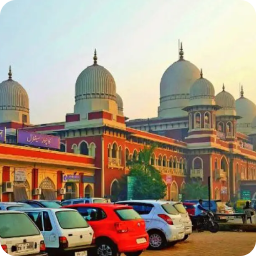| Agriculture in India: Definition, Farming System & Green Revolution |
Agriculture is a vital part of India’s economy, providing livelihoods to millions. Key inputs in farming include seeds, fertilizers, and irrigation systems. The Green Revolution significantly boosted crop production using high-yield varieties and modern techniques. Similarly, the Blue Revolution aimed to enhance fish production. Agricultural markets, like APMC (Agricultural Produce Market Committee) markets, and government schemes support farmers in selling their produce and improving productivity.
AGRICULTURE IN INDIA
| INTRODUCTION |
|
|
TARGETS |
|
|
RANKING OF INDIA |
|
|
AGRICULTURE CENSUS
|
|
Terminologies related to cropping in Agriculture in India:
| Cropping Intensity: | Number of crops cultivated in a piece of land per annum is the cropping intensity in Agriculture in India. |
| Cropping Pattern: | The cropping pattern depends on a farm and its interactions with farm resources, other farm enterprises, and available technology which determine their makeup. |
| Multiple Cropping: | Growing more than two crops in a piece of land in a year in orderly succession in Agriculture in India. |
| Inter Cropping: | Growing two or more crops simultaneously with distinct row arrangement on the same field at same time. |
Agriculture In India: Exploration Of Farming System
| Wetland Farming: | Soils flooded or irrigated through lake, pond, or canal and land is always in submerged condition in Agriculture in India. |
| Dry Land Farming: | The practice of crop production entirely depending upon rainfall and the moisture conserved in the soil. |
| Rain Fed Farming: | Crop production in Agriculture in India, particularly in areas where rainfall is, more than 750mm (i.e assured rainfall areas). |
| Mixed Farming: | System of farming on a particular farm which includes crop production, raising livestock, poultry, fisheries, beekeeping etc. |
Agricultural Progress: An In-Depth Exploration of Key Inputs in Agriculture In India
| Physical Factors | Relief + Climate + Soil |
| Institutional Factors | Land Holding + Land Tenure + Land Reforms |
| Infrastructural Factors | Irrigation + Power + Transport + Credit + Marketing + Insurance + Storage |
| Technological Factors | Seeds + Fertiliser + Insecticide + Farm Machinery |
| Other Factors | Government Policy + Extension Services + Education + Skilling |
- Land: Agriculture in India is a purely land based activity.
- Size and quality of land has a direct bearing on agriculture productivity and farmers’ income.
- Land ownership also serves as a social value & security against credit.
- Land Holding: Average landholding size of households shrank marginally to 1.1 hectare in 2015-16 from 1.16 hectare in 2012-13.
- 86.21% of India’s cultivated farmland is held by small and marginal farmers with less than 2 hectare of land;
- While those with 10 hectare and more account for just 0.57%.
Transforming the Agricultural in India Landscape: A Overview of Land Reforms in India
| Objectives: |
|
|
First Generation Land Reforms |
|
| Second Generation Land Reforms
(Focused on marketing) |
|
Agriculture in India: Exploring Irrigation Strategies for Sustainable Growth
- While Agriculture in India accounts for more than 17% of the world population, we have barely 4% of the world’s water resources.
- Irrigation water productivity in Agriculture in India is defined as the ratio of the crop output to the irrigation water applied.
- To produce 1 kg of rice, Indian farmers use 3,000-5,000 liters of water, whereas Chinese farmers manage it within 350 liters of water.
| Minor Irrigation Schemes | Up To 2000 hectares Cultivable Command Areas. |
| Medium Irrigation Schemes | 2000 hectare < Cultivable Command Areas < 10,000 hectares. |
| Major Irrigation Schemes | Cultivable command Areas > 10000 hectares. |
Understanding Agriculture in India: A Closer Look at Pradhan Mantri Krishi Sinchai Yojana (2015)
- Overview: Launched in 2015-16 to enhance water access and irrigation, improve water use efficiency, and promote sustainable water conservation.
Umbrella scheme with two major components:- Accelerated Irrigation Benefit Programme (AIBP) and Har Khet Ko Pani (HKKP).
- Accelerated Irrigation Benefit Programme (AIBP): Provides partial financial assistance for major/medium irrigation projects.
- Focus on the 99 priority projects identified in 2016-17.
- 53 projects were completed; an additional 7 projects were included from 2021-22.
- Har Khet Ko Pani (HKKP): Consists of four sub-components: Command Area Development & Water Management (CAD&WM), Surface Minor Irrigation (SMI), Repair, Renovation & Restoration (RRR) of Water Bodies, and Ground Water (GW) Development.
- Command Area Development & Water Management (CAD&WM): Started in 1974-75 to bridge the gap between irrigation potential created and utilized.
- Enhances irrigation use efficiency and agricultural production through participatory irrigation management (PIM).
- Includes micro-irrigation and underground pipeline network (UGPN) initiatives.
- Surface Minor Irrigation (SMI): Financial assistance for schemes with less than 2,000 hectares of irrigation potential.
- Extended to special category states and specific regions like DPAP, Tribal, DDP, flood-prone areas, and KBK region of Odisha.
- Repair, Renovation & Restoration (RRR) of Water Bodies: Initially launched in 2005 for 1098 water bodies.
- Extended as a state sector scheme with both external assistance and domestic support.
- Became part of PMKSY (HKKP) for continued support.
- Other Components:
- Watershed Development Component (WDC): Implemented by the Department of Land Resources, Ministry of Rural Development.
- Per Drop More Crop (PDMC): Initially part of PMKSY (2016-21), now implemented separately by the Department of Agriculture and Farmers Welfare (DoA&FW).
Growth: Understanding Fertilizers and Plant Nutrients in Agriculture in India
FERTILIZER FACTS
|
- Ideal Nitrogen: Phosphorus: Potassium (NPK) ratio in soil: 4:2:1, for India it’s 8:3:1.
| UREA | NUTRIENT BASED SUBSIDY (NBS) |
|
|
Greening Agriculture in India: The Role of Neem Coated Urea
|
Empowering Agriculture In India: Insights into Finance and Credit
- Priority Sector Lending: sectors in Agriculture in India include Micro, Small and Medium Enterprises, Export Credit, Education, Housing, Social Infrastructure, Renewable Energy, etc.
- All scheduled commercial banks and foreign banks (with a sizable presence in India) in Agriculture in India are required to set aside 40% of their Adjusted Net Bank Credit (ANDC) for lending to these sectors.
- Regional rural banks, co-operative banks and small finance banks have to allocate 75% of ANBC (Adjusted Net Bank Credit) to PSL.
- MSP Policy: The Minimum Support Price (MSP) policy guarantees farmers a fixed price for their crops, ensuring financial stability and reducing the risk of losses.
- This assurance helps farmers secure loans and credit from banks, as they have a reliable source of income. Consequently, MSP aids in better financial planning and investment in farming activities.
- Institutions: Cooperatives, NABARD, RRB’s
- Cooperatives help farmers by providing easy access to credit and collective buying power for inputs.
- NABARD (National Bank for Agriculture and Rural Development) offers financial assistance and development programs to improve agricultural productivity.
- Regional Rural Banks (RRBs) provide banking services and affordable loans tailored to the needs of rural farmers.
- Kisan Credit Card Scheme: This scheme provides farmers with easy access to short-term credit for purchasing inputs like seeds, fertilizers, and pesticides.
- It offers flexible repayment options and helps reduce the dependency on high-interest loans from informal sources.
- This scheme ensures timely financial support, enhancing agricultural productivity and income stability
- PM-KISAN: The PM-KISAN scheme provides direct financial support to farmers with regular cash transfers.
- This additional income helps farmers manage their expenses and invest in farming activities.
- It also improves their creditworthiness, making it easier to obtain loans.
Seeds of Growth: Exploring Agriculture in India
- Quality seeds are essential in Agriculture in India to increase yield; during the Green Revolution – HYV (High Yielding Variety) Seeds are used.
- Seed Village Agriculture In India: A village wherein trained group of fanners are involved in production of seeds of various crops; cater to the needs of themselves and to the neighboring villages.
- India’s Seed Bank: India has established its own seed storage facility at Chang Lain Ladakh, Jammu and Kashmir.
- Note: Svalbard Global Seed Vault is the world’s largest seed storage facility situated in Norway.
- Recently, in Agriculture in India, the Ministry of Agriculture & Farmers’ Welfare has finalized the draft Seed Bill 2019, which is under Parliament’s consideration.
- The Bill aims to regulate the quality of seeds sold and facilitate the production and supply of these seeds to farmers.
|
Agriculture in India: Growth Through Seed Replacement Rate (SRR) or Seed Replacement Ratio In Agriculture In India
- Seed Replacement Rate: Measures how much of the total cropped area was sown with certified seeds in comparison to farm saved seeds.
- Higher the Seed Replacement Ratio, higher is production as well as productivity.
- Agriculture in India suffers from a dismal seed Replacement Ratio.
| Soil Health Card |
|
DISTRIBUTION OF ESSENTIAL COMMODITIES – AGRICULTURE IN INDIA
- One of the critical aspects of Agriculture in India is the Supply of food grains and distribution of essential commodities to the poor through a network of Fair Price Shops (FPS) at subsidized prices.
| Public Distribution System: |
|
| One Nation, One Ration Card Initiative: |
|
| Food Corporation Of India |
|
| Negotiable Warehouse Receipts (NWR) |
|
FOOD CORPORATION OF INDIA: A PILLAR OF AGRICULTURE IN INDIA
Agriculture in India: Understanding Agricultural Produce Market Committees (APMC)
- APMC’s are established by the States; Aim: to eliminate the incidence of exploitation of the farmers by the intermediaries; food produce must be brought to the market; sales are made through auction.
- As per APMC Act, the sale/purchase of agricultural commodities is carried out in a specified market area; producer-dealers or traders pay the requisite market fee, user charges, levies and commissions for the commission agents (arhats); These charges were levied irrespective of whether the sale took place inside APMC premises or outside it; the charges varies widely across states and commodities.
Agriculture in India: Simplifying Trade through E-NAM
- It was launched in 2016.
- It is a pan-India electronic trading portal for farm produce which aims to create a unified national market for agricultural commodities by integrating existing APMC markets.
Agriculture in India: Understanding Minimum Support Prices (MSP)
- Minimum price set by the Government to protect farmers from the price volatility of agricultural commodities.
- Recommended by the Commission for Agricultural Costs and Prices (CACP) and approved by Cabinet Committee on Economic Affairs (Headed by PM), this involves determining the minimum support prices.
- The Food Corporation of India (FCI) is the Nodal Agency.
- As per Commission for Agricultural Cost and Prices (CACP)- there are three types of production costs:
| A2: | Actual paid-out cost. |
| A2+FL: | Actual paid-out cost plus the imputed value of family labour. |
| C2: | Comprehensive cost, including imputed rent and interest on owned land and capital. |
- CACP considers both (A2+FL) and C2 costs while recommending MSPs.
- However, C2 costs are used by CACP primarily as benchmark reference costs (opportunity costs) to see if the MSPs recommended by them at least cover these costs in some of the major producing States.
| MSP is declared on:
|
|
Agriculture in India: Understanding the Role of COSTS AND PRICES (CACP)
- The CACP is an attached office of the Ministry of Farmers and Agriculture Welfare, formed in 1965. It is a statutory body.
- It is mandated to recommend Minimum Support Prices (MSPs) to incentivize the cultivators to adopt modern technology, and raise productivity and overall grain production.
- CACP submits separate reports recommending prices for Kharif and Rabi seasons.
- Currently, the Commission comprises a Chairman, Member Secretary, one Member (Official) and two Members (Non-Official).
- The non-official members are representatives of the farming community and usually have an active association with the farming community.
Exploring Agriculture in India and SUGARCANE PRICING
- Price of sugarcane is fixed by the center/State, while the price of sugar is market determined.
- This dual pricing system aims to balance the interests of both farmers and market dynamics.
- Fair and Remunerative Price (FRP): The minimum price at which rate sugarcane is to be purchased by sugar mills from farmers; fixed by Union government based on recommendations of CACP; Governed by the statutory provisions of the Sugarcane (Control) Order, 1966 issued under the Essential Commodities Act (ECA), 1955.
- Based on the Rangarajan Committee report of reorganizing the sugarcane industry; alternative to MSP in Sugar Industry; Assures margins to farmers, irrespective of whether sugar mills generate a profit or not.
- Besides FRP, some states such as Punjab, Haryana, Uttarakhand, UP and TN announce a State Advised Price, which is generally higher than the FRP.
Highlighting Price Gaps in Agriculture in India: The Deficiency Payment Approach
- Price Deficiency Payment System to address the gaps in Minimum Support Price (MSP) based procurement of crops.
- Farmers are proposed to be compensated for the difference between the government announced MSPs for select crops and their actual market prices, a crucial aspect of agriculture in India.
- It will reduce the need for the government to procure food crops, transport and store them and then dispose of them under PDS.
- PM-AASHA also has a component of Price Deficiency Payment scheme.
- Similar state schemes are Bhavantar Bharpayee Yojna (BBY) of Haryana, Bhavantar Bhugtan Yojana (BBY) by Madhya Pradesh.
Exploring Agriculture in India: Operation Green
- Outlay of 500 crore; to promote Farmer Producers Organizations (FPOs), Agri-logistics, processing facilities and professional management; a scheme for integrated development of Tomato, Onion and Potato (TOP) value chain.
- Objectives: Enhancing value realization + Price stabilization + Reduction in post-harvest losses + Increase in food processing capacities and value addition + Setting up of a market intelligence network.
The Price Stabilization Fund of 2014 in Agriculture in India
- PSF is a Central Sector Scheme = 100% funded by the Union.
- Nodal → Govt gives Interest free loans to FCI, NAFED & other central/state agencies to procure pulses and perishable vegetables from local and foreign farmers and sell it to common man at reasonable prices.
- 2014 – set up in the agriculture in India ministry but 2016- shifted to the Consumer Affairs Ministry.
Global Trade: Agriculture in India Export Zones (2001)
- It was established through EXIM policy 1997-2001.
- It was established for the purpose of developing and sourcing the raw materials, their processing, and packaging in Agriculture in India.
Agriculture in India and Income Support: A Approach for Sustainable Growth
Agriculture in India: Pradhan Mantri Kisan Samman Nidhi (PM-KISAN):
- PM KISAN is a Central Sector Scheme.
- Income support of Rs 6000 per year in three equal installments.
- Available to all farmers irrespective of their farm size.
- Direct Benefit Transfer in beneficiary bank accounts, thus, eliminating middlemen and corruption.
- It is the first universal basic income type of scheme targeted towards farmers. The scheme aims to provide income support to farmers for easing their liquidity needs to facilitate timely access to inputs.
- Benefits:
- Easing Liquidity Constraints.
- Aids the Modernisation Process.
- Non-Discriminatory in Nature.
- Enabling the Digitisation of Land Records.
- Similar scheme in States:
| SCHEME | AREA | ASSISTANCE |
| Ryat Bandhu | Telangana | 5000 per acre per season (Rabi and Kharif). |
| KALIA scheme (Krishak Assistance for Livelihood and Income Augmentation) | Odisha | Annual assistance of Rs 12,500 each to farmers. |
| Krishak Bandhu | West Bengal | Rs 5000 to farmers in two installments. |
| Mukhya Mantri Krishi Aashirwad Yojana | Jharkhand | Rs. 5000 / – per acre per year (up to 5 acres). |
| The Rajiv Gandhi Kisan Nyaya Yojana | Chhattisgarh | Rupees 13,000 an acre a year is given. |
Agriculture in India: Empowering Farmers through PM Kisan Mann Dhan Yojana
- To provide social security to Small and Marginal Farmers in their old age.
- A minimum fixed pension of Rs.3,000/- is provided to the small and marginal farmers, subject to certain exclusion criteria, on attaining the age of 60 years.
- It is a voluntary and contributory pension scheme.
- The Central Government also contributes an equal amount to the Pension Fund.
- LIC is the fund manager and responsible for pension pay-out.
- Eligibility:
- Small and Marginal Farmer (SMF): a farmer who owns cultivable land upto 2 hectares as per land records of the concerned State/UT.
- Age of 18- 40 years
Supporting Farmers In Agriculture In India: Pradhan Mantri Annadata Aaysanrakshan Abhiyaan
- The Scheme is aimed at ensuring remunerative prices for farmers’ produce.
- Three Components of PM-AASHA:
- Price Support Scheme: physical procurement of pulses, oilseeds and Copra will be done by Central Nodal Agencies with a proactive role of State governments.
- Price Deficiency Payment Scheme (PDPS): This scheme does not involve any physical procurement of crops as farmers are paid the difference between the MSP price and Sale/model price on disposal in the notified market.
- Private Procurement & Stockist Scheme (PPPS): The selected private agency will be hired to procure the commodity at MSP in the notified markets on behalf of the government.
Key Committees and Their Roles in Agriculture in India
| National Commission on Farmers/ Swaminathan Committee (2004) |
|
| Beekeeping Development Committee |
|
|
Shanta Kumar committee (2014) |
|
|
Ashok Dalwai committee (2016)
|
|
Agriculture in India: Other Groups Impacting Farming
| Small Farmer Agri Business Consortium |
|
| APEDA |
|
|
FPOs |
|
Agriculture in India: Empowering Farmers through Contract Farming
- Contract farming is based on a pre-harvest agreement between the buyers and producers.
- It is under the Concurrent List under the seventh schedule of the Indian constitution.
Agriculture in India: Making Futures with the Model Contract Farming Act (2018)
- This ensures buying of the entire pre-agreed quantity and price from the farmers.
- All pre-production, production and post-production services are under its ambit.
- Bar the transfer of ownership of the farmer’s land to sponsor companies.
- Contract farming will remain outside the ambit of the respective Agricultural Produce Marketing Act of the states/UTs.
- Limits of stockholding of agricultural produce will not be applicable to produce purchased under contract farming.
Agriculture in India: Essential Commodities with the Essential Commodities Act (1955)
- There is no specific definition of essential commodities in The EC Act.
- To regulate the production, supply and distribution of commodities. It declares ‘essential’ in order to make them available to consumers at fair prices.
- The Central government can add or remove a commodity in the Schedule of the Act.
- The government can also fix the maximum retail price (MRP) of any packaged product that it declares an “essential commodity”.
Agriculture in India and Growth with the Agriculture Infrastructure Fund
- Agriculture Infrastructure Fund: AIF scheme is a Central Sector Scheme offering a medium-long term debt financing facility of Rs.1 lakh crore for funding agriculture infrastructure to support and promote agricultural development, improve productivity, and address challenges faced by farmers, agribusinesses, and the overall agricultural industry.
- It will provide a medium- to long term debt financing facility for investment in viable projects for post-harvest management Infrastructure and community farming assets through interest subvention and financial support.
- Total Loan Amount: Rs. 1 Lakh Crore provided by banks and financial institutions.
- Eligible Entities: Primary Agricultural Credit Societies (PACS), Marketing Cooperative Societies, Farmer Producers Organizations (FPOs), Self Help Groups (SHG), Farmers, Joint Liability Groups (JLG), Multipurpose Cooperative Societies, Agri-entrepreneurs, Startups, Aggregation Infrastructure Providers, Public-Private Partnership Projects by Central/State agencies or local bodies
- Loan Distribution:
- Year 1: Rs. 10,000 crore
- Years 2-4: Rs. 30,000 crore each year
- Interest Subvention: 3% per annum on loans up to Rs. 2 crore
- Valid for up to 7 years
- Credit Guarantee: Available under CGTMSE scheme for loans up to Rs. 2 crore
- Government pays the coverage fee
- FPOs can get credit guarantees from DACFW’s FPO promotion scheme
- Government Budget Support: Rs. 10,736 crore
- Repayment Moratorium:
- Minimum: 6 months
- Maximum: 2 years
- Job Creation: Expected to create many jobs in rural areas through formal credit for farming and processing activities.
- Management System: Online MIS platform for loan applications and management
- Transparency in interest rates and scheme benefits
- Minimum documentation and faster approval process
- Integration with other schemes
- Monitoring: National, State, and District level Monitoring Committees for real-time oversight and feedback
- Scheme Duration: FY2020 to FY2029 (10 years)
Agriculture in India: Sustainable Growth with Organic Farming
- India ranks 1st in number of organic farmers and 9th in terms of area under organic farming.
- Sikkim became the first State in the world to become fully organic in 2016.
- The major organic exports from India have been flax seeds, sesame, soybean, tea, medicinal plants, rice and pulses.
- There was an increase of nearly 50% in organic exports in 2018-19, touching Rs. 5151 crore.
Agriculture in India: Change through Government Initiatives for Organic Farming
| Mission Organic Value Chain Development for North East Region (MOVCD): |
|
| Paramparagat Krishi Vikas Yojana (PKVY): |
|
| National Program for Organic Production (NPOP): |
|
| PM Formalization of Micro Food Processing Enterprises (PM-FME): |
|
Agriculture in India: Sustainability through Zero Budget Natural Farming (ZBNF)
- Addressing the United Nations conference on desertification (COP-14), Indian PM told the global community that India is focusing on Zero-Budget Natural Farming (ZBNF).
- ZBNF was also highlighted in budget 2019 in the bid to double farmer’s income by 2022.
- ‘Zero Budget’ means without using any loan, and without spending any money on purchase of inputs (seeds, fertilizers).
- ‘Natural farming’ means farming without chemicals. By using biofertilizers, earthworms, cow dung etc.
- It was originally promoted by agriculturist Subhash Palekar,who developed it in the mid-1990s as an alternative to the Green Revolution’s methods that are driven by chemical fertilizers and pesticides and intensive irrigation.
ZBNF: Embracing Sustainable Farming Practices in Agriculture in India
| Jeevamrutha: | It is a mixture of fresh cow dung and aged cow urine (both from India’s indigenous cow breed), jaggery, pulse flour, water and soil; to be applied on farmland. |
| Bijamrita: | It is a concoction of neem leaves & pulp, tobacco and green chilies prepared for insect and pest management, that can be used to treat seeds. |
| Acchadana (Mulching): | It protects topsoil during cultivation and does not destroy it by tilling. |
| Whapasa: | It is the condition where there are both air molecules and water molecules present in the soil. Thereby helping in reducing irrigation requirements. |
Innovation in Agriculture in India : Recent Government Policies
| Agri Reforms Bill | Pros | Cons |
| The Farmers’ Produce Trade and Commerce (Promotion and Facilitation) Act, 2020 |
|
|
| The Farmers (Empowerment & Protection) Agreement of Price Assurance and Farm Services Act, 2020 |
|
|
| The Essential Commodities (Amendment) Act, 2020 |
|
|
WTO Agreements in the Context of Agriculture in India
- Domestic Support: given to the farmers for encouraging agricultural activities- research and development, food security subsidies.
- AOA classifies subsidies in different boxes to regulate the agricultural subsidies through the following mechanisms.
AGREEMENT ON AGRICULTURE: Alternative Approaches in Agriculture in Indian
- AoA is aimed to remove trade barriers and to promote transparent market access and integration of global markets.
- It stands on following three pillars:
| MARKET ACCESS | DOMESTIC SUPPORT | EXPORT COMPETITION |
| Tariffs: Tariffication and Reduction Commitments |
|
|
| Green Box |
|
| Amber Box / Aggregate Measure Of Support (Ams) |
|
| Blue Box |
|
| De-Minimis support |
|
| Special and Differential Treatment Box |
|
| Sanitary and PhytoSanitary Measures |
|
Changes in Agriculture In India: Exploring Various Revolutions in India |
|
|
Green Revolution |
It was done in two phases:
Bringing Green Revolution In Eastern India
|
| Blue Revolution- Fisheries |
BUDGET 2020:
|
|
White Revolution- Milk |
|
Improving Animal Farming for Better Agriculture in India |
- DPSP Article 48: requires the State to organize animal husbandry on modern and scientific lines, preserving and improving breeds, and prohibiting the slaughter of cows and other cattle.
- BUDGET 2020: To eliminate following disease by 2025:
- Cattle: Foot and Mouth disease, Brucellosis,
- Sheep and Goat: Peste Des Petits Ruminants(PPR)
- Use MGNREGA workers to develop fodder farms.
Agriculture in India: Connected Programs and Initiatives |
| Pashudhan
Sanjivani |
|
| e-Pashudhan
Haat portal |
|
|
Rashtriya Gokul |
|
| National
Kamdhenu breeding center |
|
| Rashtriya
Kamdhenu Aayog 2019 |
|
Conclusion
Indian agriculture has evolved significantly with advancements in seeds, irrigation, and market structures. The Green and Blue Revolutions have played a crucial role in increasing food and fish production. Government schemes continue to support farmers, ensuring they have the necessary resources and market access. Despite challenges, these efforts collectively aim to sustain and grow the agricultural sector, securing food for the nation.































